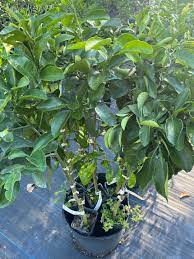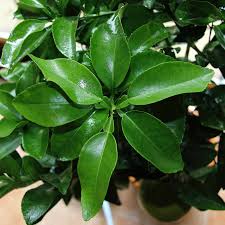Grapefruit leaves are the leaves of the grapefruit tree (Citrus × paradisi), which is a subtropical citrus fruit tree belonging to the Rutaceae family. Grapefruit leaves are typically dark green, glossy, and have a slightly fragrant aroma, much like other citrus tree leaves. These leaves are an essential part of the grapefruit tree and play a vital role in photosynthesis, where they capture sunlight and convert it into energy for the plant.
Grapefruit leaves can vary in size, shape, and texture, but they are usually elliptical or oblong with a pointed tip. They are arranged alternately on the branches of the tree. Like most citrus leaves, grapefruit leaves are evergreen, meaning they remain on the tree throughout the year and do not drop in the winter.
Grapefruits leaves, like the fruit itself, contain aromatic compounds that contribute to the overall scent of the tree. These compounds, found in the oil glands of the leaves, release a pleasant citrus fragrance when the leaves are crushed or rubbed. This fragrance is often used in aromatherapy and perfumery.
In addition to their aromatic properties, grapefruit leaves can be used in various culinary and herbal applications. Some people use them to make tea or infusions, believing they may have potential health benefits. However, the primary use of grapefruit trees is for their delicious and juicy fruits, which are consumed fresh, juiced, or used in a variety of culinary dishes and beverages. The leaves themselves are not commonly used in cooking but are valued for their ornamental and aromatic qualities in gardens and landscapes.
The Economic Importance and Uses of Grapefruit Leaves

Grapefruit leaves, like many other plant materials, have various potential economic uses and benefits. While some of these applications may be less common or well-documented compared to the fruit itself, grapefruit leaves can still be valuable in several ways:
1. Traditional Medicine: Grapefruit leaves have been used in traditional medicine in some cultures for their potential health benefits. They are believed to possess anti-inflammatory and antioxidant properties, which may help with various health issues when used in herbal remedies.
2. Essential Oils: Grapefruit leaves can be a source of essential oils used in the fragrance and cosmetic industries. These oils may contain compounds like limonene, which have a pleasant citrus aroma and are used in perfumes and aromatherapy.
3. Flavoring Agents: Extracts from grapefruit leaves can be used as natural flavoring agents in food and beverages.
4. Animal Fodder: Grapefruit leaves can be used as a supplementary feed for livestock, particularly in regions where they are abundant. The leaves are a good source of fiber and some essential nutrients, contributing to animal nutrition.
5. Mulching Material: Shredded or composted grapefruit leaves can be used as organic mulch in gardens and agricultural settings. They help retain soil moisture, suppress weeds, and improve soil fertility as they decompose.
6. Compost: When added to compost piles, grapefruit leaves provide organic matter and nutrients, enhancing the overall quality of compost for use in agriculture.
Read Also: Grapefruit Stem: Economic Importance, Uses and By-Products
7. Insect Repellent: Extracts from grapefruit leaves have been tested for their potential as natural insect repellents and pesticides. Certain compounds in the leaves may deter or kill pests, reducing the need for chemical pesticides.
8. Craft Materials: Dried grapefruit leaves can be used in craft projects, such as wreaths and floral arrangements, for their attractive appearance and natural fragrance.
9. Ornamental Plant: Grapefruit trees, including their leaves, are sometimes grown for their aesthetic value in gardens and landscaping, providing shade and an appealing green backdrop.
10. Erosion Control: Planting grapefruit trees for their leaves can help with soil erosion control in certain regions, thanks to their extensive root systems and ground cover.
11. Botanical Studies: Grapefruits leaves are valuable for botanical research, helping scientists better understand the biology, ecology, and genetics of the grapefruit tree.
12. Natural Dye: In some traditional practices, grapefruit leaves have been used to create natural dyes. The leaves contain pigments that can produce various shades of yellow and green, which can be used for coloring textiles and crafts.
13. Biofuel Production: Like many plant materials, grapefruits leaves can be used as a source of biomass for biofuel production. The cellulose and lignin content in leaves can be converted into biofuels through processes like fermentation and pyrolysis.
14. Educational and Research Tools: Grapefruit leaves serve as valuable educational tools for botany students and researchers studying plant structure, leaf morphology, and photosynthesis. They can be used for practical demonstrations and experiments.
15. Alternative Medicine: Some alternative medicine practices utilize grapefruit leaves for their potential therapeutic effects. This may include the use of grapefruit leaf extracts in herbal teas, tinctures, or supplements for various health-related purposes.
16. Culinary Uses: In some culinary traditions, grapefruit leaves are used as a flavor enhancer or a wrapping material for cooking certain dishes. They can infuse subtle citrus notes into food.
17. Aroma Diffusion: Dried grapefruit leaves can be used in potpourri and sachets to add a pleasant, natural fragrance to indoor spaces.
18. Bee Forage: Grapefruits trees, including their leaves, produce nectar and pollen, making them attractive to pollinators such as bees. This can indirectly support local honey production and crop pollination.
19. Soil Improvement: When grapefruits leaves decompose, they enrich the soil with organic matter and improve its structure, which can benefit nearby vegetation and agricultural crops.
20. Sustainable Agriculture: Incorporating grapefruit trees into agroforestry systems can promote sustainable agriculture by providing shade, conserving soil, and diversifying crop options.
The Products and By-products That Can Be Derived From Grapefruit Leaves
Grapefruit leaves, like many plant materials, can be utilized to produce various products and by-products.
Here is a list of potential products and by-products that can be derived from grapefruit leaves, along with brief explanations:
1. Essential Oil: Grapefruits leaf essential oil is the primary product obtained from grapefruit leaves. It is extracted through steam distillation. Grapefruit leaf oil is used in aromatherapy, perfumery, and as a flavoring agent in food and beverages due to its citrusy aroma and flavor.
2. Herbal Tea: Dried grapefruits leaves can be used to make herbal tea. Grapefruit leaf tea is known for its potential health benefits, including antioxidant properties and its ability to support digestion.
3. Natural Pesticide: Extracts from grapefruit leaves can be used to make natural pesticides. These pesticides may help control various garden pests and insects, as grapefruit leaves contain compounds that are toxic to certain pests.
Read Also: Worm Infestation on Ruminant Animals: Symptoms and Treatment
4. Potpourri: Dried grapefruit leaves can be added to potpourri mixtures to provide a pleasant citrusy scent. This can be used to freshen up indoor spaces or add fragrance to closets and drawers.
5. Mulch: Chopped or shredded grapefruit leaves can be used as organic mulch in gardens. This helps retain soil moisture, suppress weeds, and improve soil quality as the leaves decompose.
6. Compost: Grapefruit leaves can be composted along with other organic materials. As they break down, they contribute valuable nutrients and organic matter to the compost, enriching the soil.
7. Animal Feed: In some cases, grapefruit leaves can be fed to livestock as a source of roughage and nutrients. However, this usage is less common compared to other parts of the grapefruit tree.
8. Biofuel: While not a primary product, grapefruit leaves, along with other plant materials, can be considered for use in biofuel production. The cellulose and lignin present in the leaves can be converted into biofuels through various processes.
9. Craft Materials: Grapefruit leaves can be used for crafting purposes. They can be pressed and dried to create decorative materials for various projects, such as greeting cards and scrapbooking.
10. Natural Dyes: The leaves contain pigments that can be used as natural dyes for fabrics and textiles. The color obtained may vary depending on the part of the leaf and the extraction process.
11. Medicinal Extracts: Some traditional herbal medicine systems use grapefruit leaf extracts for their potential health benefits, such as their antioxidant properties and potential antimicrobial effects. However, more research is needed to validate these claims.
In conclusion, it is important to note that while grapefruit leaves offer a range of potential uses, some of these applications may be limited by the availability of leaves and the specific cultivar of grapefruit tree. Additionally, before using grapefruit leaves for any medicinal or dietary purposes, it’s advisable to consult with a healthcare professional or botanist to ensure safety and effectiveness.
Read Also: 9 Impressive Health Benefits of Onions

